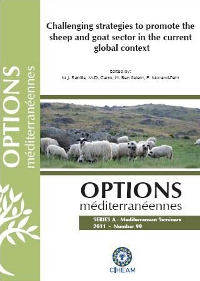| Article précédent | p. 157-162 | Article suivant |
Comparison of direct and indirect methods for estimating microbial protein synthesis in sheep
The aim of this work was to compare the values of rumen microbial N duodenal flow (MNDF) obtained from duodenal flow measurements using 15N as microbial marker with those estimated from the urinary excretion of purine derivatives (PD) and allantoin. Six ruminally and duodenally cannulated sheep were used in a partially replicated Latin Square design. The four experimental diets had forage:concentrate ratios of 70:30 (HF) or 30:70 (HC) and either alfalfa hay (A) or grass hay (G) as forage, and were designated as HFA, HCA, HFG and HCG. Duodenal digesta flows were determined by the dual-phase marker technique using Cr-mordanted fibre and Co-EDTA as solid and fluid digesta marker, respectively. The MNDF was estimated from duodenal flow of 15N using as reference liquid- (LAB) and solid-associated (SAB) bacteria isolated from the rumen, and indirectly from the urinary excretion of PD and allantoin using response models from the literature. Estimates of MNDF with 15N-SAB as reference were 8.3, 7.1, 11.1 and 9.8 percent greater for HFA, HCA, HFG and HCG diets, respectively, than those obtained with 15N-LAB, but both bacterial isolates detected the same significant differences among diets. Compared with 15N, the urinary excretion of both total PD and allantoin produced lower estimates of MNDF for HFA, HCA and HCG, but values for the HFG diet were similar. Averaged across diets, MNDF values obtained from the urinary excretion of PD and allantoin were 14.9 and 7.9 percent lower than those obtained with 15N and LAB as reference, and 22.3 and 15.9 percent lower than those obtained with 15N and SAB as reference. All methods detected the same significant differences among diets, indicating that urinary excretion of PD constitutes a reliable method for estimating MNDF.
L'objectif de ce travail était de comparer les valeurs du flux duodénal d'azote microbien (MNDF) obtenues à partir de mesures du flux duodénal en utilisant 15N comme marqueur microbien avec celles estimées à partir de l'excrétion urinaire des dérivés puriques (PD) et de l´allantoïne. Six moutons munis de canules ruminale et duodénale ont été utilisées selon un dispositif en carré latin double. Les quatre régimes expérimentaux désignés HFA, HCA, HFG et HCG ont des rapports fourrage : concentré de 70 : 30 (HF) ou 30 : 70 (HC) et le foin de luzerne (a) ou le foin (G) d'herbe comme fourrage. Les flux de digesta duodénal ont été déterminés par la technique de marqueur de double phase en utilisant les fibres mordancées au chrome et le Co-EDTA comme marqueurs des phases, respectivement, solide et liquide. La MNDF a été estimée à partir du flux duodénal de 15N en utilisant comme référence les bactéries associées à la phase liquide (LAB) et à la phase solide (SAB) du rumen, et indirectement à partir de l'excrétion urinaire de PD et d'allantoïne utilisant des modèles de réponse rapportés dans la littérature. Les estimations de MNDF avec 15N-SAB comme référence ont été 8,3; 7,1; 11,1 et 9,8 pour cent plus élevés pour les régimes HFA, HCA, HFG et HCG, respectivement, que ceux obtenus avec 15NLAB, mais les deux isolats bactériens ont détecté les mêmes différences significatives parmi des régimes. Comparée avec le 15N, l'excrétion urinaire totale des PB et de l´allantoïne ont produit de faibles estimations de MNDF pour les régimes HFA, HCA et HCG, mais les valeurs pour le régime HFG ont été semblables. Les valeurs de MNDF obtenues à partir de l'excrétion urinaire du PD et l'allantoïne on été 14,9 et 7,9 pour cent inférieurs à celles obtenues avec 15N et LAB comme référence, et 22,3 et 15,9 pour cent inférieurs à celles obtenues avec 15N et SAB comme référence. Toutes les méthodes ont détecté les mêmes différences significatives parmi des régimes, indiquant que l'excrétion urinaire du PD est une méthode fiable pour estimer MNDF.
- [ Afficher ]
- [ Télécharger ]
- [ Exporter la citation ]
Vous pouvez télécharger la citation au format :
- [ Imprimer ]
-
Mots-clés
ALIMENT CONCENTRE POUR ANIMAUX, AZOTE, FOURRAGE, OVIN, PROTEINE MICROBIENNE, PURINE, ALLANTOINECiter cet article
Ramos S., Tejido M.L., Martínez M.E., Ranilla M.J., Saro C., Carro M.D. Comparison of direct and indirect methods for estimating microbial protein synthesis in sheep. In : Ranilla M.J. (ed.), Carro M.D. (ed.), Ben Salem H. (ed.), Morand-Fehr P. (ed.). Challenging strategies to promote the sheep and goat sector in the current global context. Zaragoza : CIHEAM / CSIC / Universidad de León / FAO, 2011. p. 157-162. (Options Méditerranéennes : Série A. Séminaires Méditerranéens; n. 99). 13. International Seminar of the Sub-Network on Nutrition of the FAO-CIHEAM Inter-Regional Cooperative Research and Development Network on Sheep and Goats, 2009/10/14-16, León (Spain). http://om.ciheam.org/om/pdf/a99/00801550.pdf



